



Manure Treatment Strategies - GHG Emissions - Manure Management - Digestate - Nutrient Recovery - Crop Sustainability




LIMIT DGGAS project is aimed to test treatment strategies based on the recovery of nutrients in digestate, in order to produce new types of fertilizers or amendments. The project will also investigate the fertilization efficiency of anaerobic digestors effluents, monitoring gaseous emissions from different sources along the production chain.
LIMIT DGGAS project will trace the road for a control on by-products quality, valorization of agronomic utilization of digestate, reduction of environmental effects due to the release of pollutant gases, as required from policy-makers and stakeholders.

The project will benefit the cooperation of a group of scientists from different field of expertise, with different approaches and methodology trying to overcome current constraints of manure based digestate chain. Basing on the background presented, the objectives of this project are:
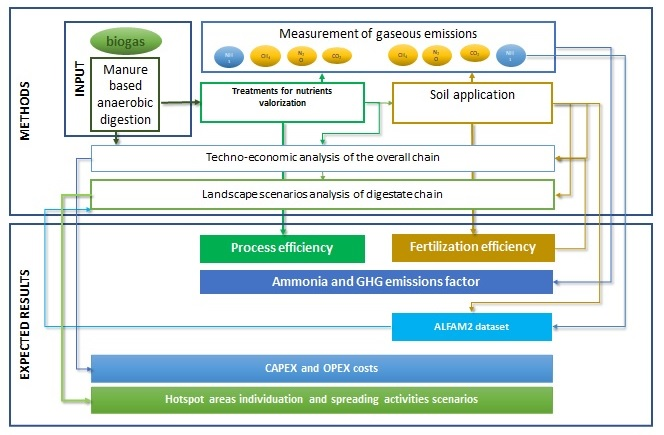
Each one of these objectives will be developed according to a proper methodology described in detail as follows:
Treatment strategies considered for the aim of the project, are adopted in two already existing plants for the treatment of livestock effluents, located in Piedmont and Campania region. Specifically, one treatment is based on a sorbent barrier made of zeolite, acting as a trap for nutrients, purifying the liquid fraction of the digestate. The second technology selected is based on ammonia stripping from the liquid fraction of the digestate, followed by an enrichment in NH4 of the solid digestate used as a filter for gas leaving the stripping tower. The enriched filter is used as a bulk agent for vermicompost. This system is patented as Green Cycle System (GCS). Both plants produce a fertilizer or amendment certified. Both the process will be analyzed as a whole, from digestate production to the agronomic utilization of the output materials. For each treatment step, energy requirement, nutrients mass balance, NH3 and GHG losses will be monitored, to evaluate the economic and environmental sustainability of the whole process. A more detailed description of the functioning of the two processes, and of the activities to develop are reported as follows.
An existing prototype system for nutrient recovery from digestate will be implemented and tested at the biogas plant of the MAGIM – Società Cooperativa Agricola, a pig farm located in Racconigi, in the Cuneo Province. The farm rears 3,000 sows (weight 180 kg), 1,000 piglets (up to 3 months old and weight 30 kg), and 3,000 fattening pigs (weight 90 kg). The total utilized agricultural area is 500 ha, devoted to cereal (mainly maize) production. Since December 2012 a biogas plant with an installed capacity of 0.800 MWel has been operating at the farm. The biogas plant is mainly fed with pig manure (raw slurry, separated solid fraction of raw slurry) and energy crops produced by the pig farm. An innovative digestate post-treatment system developed by E.S.E.A. Co.Lt., based on a two-stage solid/liquid separation unit combined with a zeolite filter unit (Figure 3) for digested liquid fraction nutrient recovery, has been recently installed to improve the overall sustainability of the anaerobic digestion system. Digestate from the biogas plant is separated with a screw press separator to obtain a solid (SF1) and a liquid (LF1) fraction.
A highly efficient separation device (e.g., decanter centrifuge) further separates the LF1, and the obtained supernatant (LF2) is then filtered through a specific zeolites bed characterized by high Cation-exchange capacity (C.E.C.).
The output products are:
The process is aimed at:
The efficiency of the system is determined by several parameters such as the type of used zeolite, operational parameters (eg., slurry flow rate) and chemical and physical characteristics (e.g., particle size and total solids content) of digestate, which can be very heterogeneous. An investigation conducted by DISAFA revealed frequent stops of the system, mainly due to operational problems (e.g., clogging) of the decanter centrifuge. Moreover, digestate centrifugation is a process requiring high capital costs and a high-power input. Therefore, An analysis of existing options will be carried out to identify an economical and reliable method for digestate separation. Then, the efficacy of the system in recovering nutrients from digestate will be evaluated through the analyses of the physical and chemical characteristics (e.g., total solids – TS, total nitrogen - TN, total ammonia nitrogen - TAN, total phosphorus - TP, total potassium - TK, zinc – Zn, and copper – Cu) of the inlet and the output materials (both solid and liquid fractions) at each treatment step.

The GCS developed by the CF Energy Service S.r.l., is aiming at integrating livestock manure treatment and the production of sterilized bio-based fertilizers (Fig.2). The plant is located in Capaccio (SA), a small town in the Salerno Province, where are reared more than 20000 buffalo heads for milk production. The plant is fed by three surroundings buffalo farms, connected by pipelines. The total daily processing capacity is of 20500 kg/day of different agricultural organic waste, divided as follows: 78% buffalo manure, 12 % olive mill wastewater, 3% dairy serum, and 7% agricultural waste. The system is made up of an anaerobic digester of about 3600 m3, (with an installed capacity of 249 kWel) followed by a stripping tower and an open vermicomposting process of the digestate solid fraction. Specifically, the liquid digestate is forced into the stripping tower, where it is invested by the high temperature of exhaust gases from the combined heat and power (CHP) generator. The gases are conveyed and circulated from the bottom of the tower, while the liquid fraction of digestate is nebulized from the top. The ammonium is then extracted with a blower and the sucked flow is then conveyed into a biofilter where it meets the remaining solid fraction of the digestate.
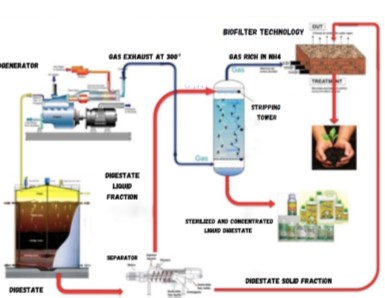
The biofilter retains the ammonia and converts it into organic nitrogen, and the high temperatures suppress pathogenic germs and weed seeds present in the solid fraction. The earthworm breeding produces a fertilizer rich in humic and fulvic acids, which can be used in organic agriculture. This type of treatment plant is not reported before in the scientific literature, for this reason, advantages and constraints of this promising approach are still unknown. From a previous assessment on different sampling points of the plant, some unexpected results were found such as the presence of torrefied material in the liquid stripped fraction that is worthy of investigation. To this purpose, the main characteristics (TS, VS, total N and TAN, total phosphorus - TP, total potassium - TK, zinc – Zn, and copper – Cu) of the influent and effluent materials will be monitored twice per month, for one year, in order to evaluate the treatment efficiency and characterize all the effluents of the plant. The effluents to be characterized and tested for agronomic utilization are the following:
Activities to assess the agronomic value of the effluents (Subedi et al., 2016) will be carried out at mesocosm scale. A set of experiments in controlled or semi-controlled conditions will be performed at two sites, UNITO and UNINA. Treatments will include raw and treated digestates produced in the treatment plants, an unfertilized control, and a control treated with mineral fertilizers. The plant grown in optimal conditions will be used as a bio-indicator of the nutrient-use efficiency. Crop biomass production and nutrient uptake will be used to calculate standard nutrient use efficiency indicators. This finding will be used to evaluate the nutrient availability for the crop and to demonstrate the environmental and agronomic performance of improved digestate management chains. In detail, two sets of mesocosm experimental units will be arranged for soils with contrasting physico-chemical properties to compare different fertilization treatments (raw and processed liquid and solid manures for a total of at least 4 manures; mineral fertilization treatment, and unfertilised control as references). Parallel experiments will be set in the two units UNINA and UNITO. Italian Ryegrass (L. multiforum) (Figure 4), a key-crop of Italian forage-cropping systems, will be used as a bioindicator of nutrient availability.
The crop will be cut twice to assess also the medium-term fertilizer efficiency. Mesocosm will be grown in semi-controlled conditions to ensure a good crop status and growth. Fertilizers will be mixed with the mesocosm soil and Italian ryegrass will be sown, thus simulating a pre-sowing distribution followed by tillage. irrigation will be performed based on a simple water balance calculation and leaching will be measured or prevented. At least three replicates will be performed for each treatment. Soil texture analysis will be conducted using the Bouyoucos hydrometric method. Soil pH and EC will be measured on 1:2.5 and 1:5 soil (g) water (mL) suspensions, respectively. Soil nitrogen (total N) concentration will be assessed after mineralization with sulfuric acid (96%) in the presence of potassium sulfate and a low concentration of copper by the Kjeldahl method. Mineral N will be determined spectrophotometrically (FIAstar 5000 Analyzer, FOSS Analytical, Hillerød, Denmark) on soil extracts. Gas semi-permeable membrane method (ISO11732 procedure) will be carried out for NH4-N, while the sulphanilamide-naphtylethylendiamine dihydrochloride method will be carried out to analyze NO3 − after nitrate to nitrite reduction with a copper–cadmium column (ISO 13395 procedure). Soil P content will be measured according to the Olsen method while ammonium acetate method will be adopted for exchangeable K. Scheibler calcimeter will be used for determination of soil limestone content. Soil C will be measured according to the Walkley–Black method and reported as soil organic matter (SOM% = C% × 1.726). Plant dry tissues will be finely ground in an electric mill (Wiley mill-IKA, MF10.1, Staufen, Germany) for determination of the total N (Kjeldahl method). Total phosphorous in plant tissues will be determined by a colorimetry on the wet digested dry sample Plant N and P uptake will be estimated by multiplying dry biomass by nutrient concentration of plant tissues. A simplified N and P balance will be assessed as the difference between plant uptake and nutrient inputs supplied by fertilization. Plant nutrient uptake measured on the unfertilized control soils will be used to assess soil native availability of monitored nutrients, while soil NP variations and plant uptake on both fertilized/unfertilized soils will be involved in calculations of nutrient use efficiency according to Congreves et al. (2021).
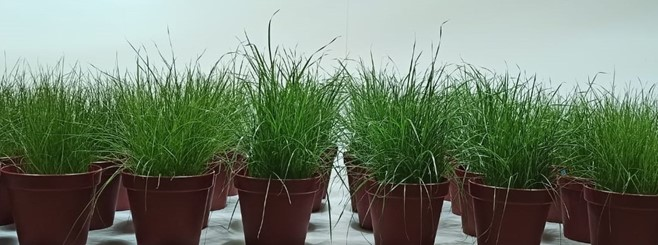
Gaseous emissions from digestate treatment plants, storage and field application of the treatment effluents will be measured according to different available techniques. For instance, two distinct situations will be identified:
Static or dynamic chambers will be adopted in the first case while methods for measuring concentration in the air, transforming it into emissions with dispersion models, will be used together with chambers in the second case. For each individual situation, methodology will be described in the specific section.
At biogas plant, ammonia and GHG emissions from all emitting sources (solid fractions from separation process, the sorbent zeolite filter, percolate from the sorbent zeolite filter) will be evaluated by using a set of wind tunnels (Balsari et al., 2007) coupled with a Photoacoustic analyzer (QEPAS). Each wind tunnel (Figure 5) consists of a fan, a hose, a mixing chamber, the tunnel body, pontoons made of stainless-steel pipes, an expansion chamber and a sampling point. Each trial will last for 3 months with at least 2 sampling a week.
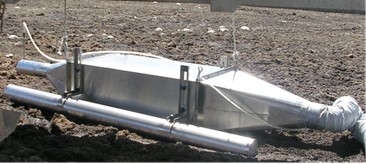
Measurements will be conducted both at laboratory and open field conditions, for different purposes. Specifically, laboratory tests will be implemented in order to quantify emissions of NH3, CH4 and N2O considering the storage conditions of the following materials:
For the purpose, dynamic chamber technique will be considered to measure NH3 emissions (Figure 6). With this procedure is possible to simulate both storage conditions and soil applications. The air sample will be analyzed using a gas-sensitive semiconductor and electrochemical sensors (Aeroqual, series 500) to detect the real-time NH3. The fluxes will be calculated from the airflow rate and concentrations value of the inlet and outlet. Vessels containing effluents to be tested will be positioned a climate-controlled room (2 m (H) 2,5 m (W) 2,5 m (L)) (Scotto di Perta et al., 2020). GHG will be measured by vented chamber described by Parkin and Venterea, 2010. Gaseous sampling at times 0, 20 and 40 min will be performed by inserting a polypropylene syringe into the chamber septa and slowly removing a gas sample. The sample can be stored directly in the syringe, before being analyzed in the gas chromatograph. Gaseous emissions will be then calculated according to Collier et al. (2014) and Parkin and Venterea (2010).

Moreover, a low-cost acid traps-open chamber (Figure 7) introduced and calibrated by Araújo et al. (2009) will be used to measure NH3 emissions at treatment plant, during the enrichment of the solid fraction of digestate with exhaust gas from the stripping tower.
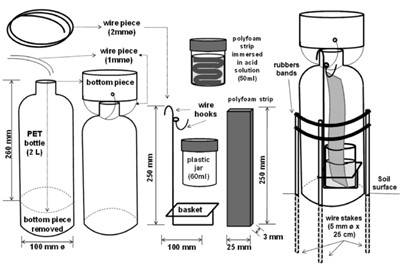
In order to provide a good dataset for ALFAM2 (https://projects.au.dk/alfam/) different techniques will be adopted. Ammonia emissions after application of the treatment effluents will be assessed applying a micrometeorological method, by means of passive ammonia samplers (alpha-samplers, Tang et al., 2018). This technique will be used to measure emissions from treatment plant effluents applied to the field. The number and position of the mast to be used (each with three passive samplers) will be defined according to the application. The backward Langrangian stochastic (bLS) dispersion model will be used to infer the total NH3 emission, using “WindTrax” software, described in detail in Flesch et al. (2004) and available at http://www.thunderbeachscientific.com. Ammonia emission after field applications will be measured using three wind tunnels (Scotto di Perta et al., 2016) already in the availability of UniNA, consisting of an open chamber placed on a rectangular area (0.32 m2), which simulate the wind action on a fertilized surface by means of a fan (Figure 8).
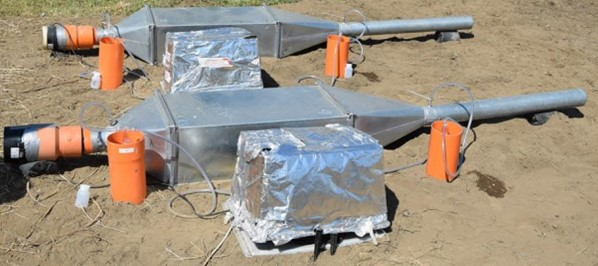
Field scale experiments will be carried out on plots of about 700 m2 each, via a closed static chamber method (Figure 9) according to Bertora et al. (2018). The technique provides for the insertion of a steel anchor (15 cm depth) into the soil, to isolate a soil column preventing lateral gas diffusion. The anchors remain inserted into the soil for the whole growing season. For each measurement point the chamber will be covered with a sealed and isolated steel lid. Three air samples will be taken from the chamber via a plastic syringe, at 0, 10 and 20 minutes from chamber closure, then transferred into glass vials to be analysed by gas chromatography for CO2, CH4, and N2O concentration. The gas accumulation pattern will be used to calculate GHG soil flux over time.
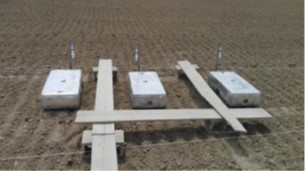
In order to provide a dataset for the development of the ALFAM2 project (https://projects.au.dk/alfam/) for comprehension and predicting ammonia loss from field-applied manure in different environmental conditions and manure of various animal species, field experimental trials will be carried out, using treatment plants effluents. Specifically, NH3 emissions will be measured with different techniques (chambers and micrometeorological methods), together with soil and fertilizers characteristics and weather conditions. Dataset will be organized according to recommendations listed at section 3.5 of Hafner et al. (2018)
To analyze the economic feasibility of the two hypotheses of digestate treatment system, costs and revenues components will be evaluated. The investment and operating costs will be discussed, based on plant operators’ data as well as on the market analysis for costs evaluation. In order to compare the two hypotheses, the Net Present Value (NPV) and the internal rate of return are used as valuation criteria (Scotto di Perta et al., 2019). Specifically, NPV is the sum of the expected net cash flows measured in today’s currency (Gebrezgabher et al., 2010) (Eq 1): \(\displaystyle NPV=-CC+\sum_{t=0}^n \frac{CF_t}{(1+r)^t}\)
where CC is the initial capital cost, r is the discount factor and CF is the expected cash flow at time t. Generally, CF is a function of incomes related to the different systems and operating costs. The income per year is given by Equation 2:
where TE is the price of the sale of electricity produced and EP (kWh d–1) is the electrical power produced per hour.
Starting from the awareness that the effects of livestock farming are not limited to the field scale, a territorial scale analysis will be performed to support and integrate mitigation strategies (Cervelli et al., 2021). The work will entail three main steps:
First step is the building of the landscape “Demand” corresponding to the quantification of nitrogen applied to the field, derived from the consistency and composition of the herds in the study area.
“Focus Area” (FA) identification. The FAs are the hotspots with the highest concentration of nitrogen in the field.
Landscape “Offer” creation, that is the identification of suitable areas for manure treatment plants or slurry spreading activities. A scenario-based Spatial-MultiCriteria Decision Analysis process (Figure 10) will be developed, supported by the panel of experts’ opinions (compared to those of different types of stakeholders), in order to identify the areas suitable for collective treatment plants and for spreading activities.
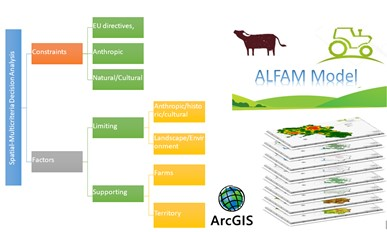
Expected results of the projects are:
Dissemination of the project results will be ensured through the following actions:
The aim is to maximize the scientific impact and the visibility of the project, promoting constant and open debate on project’s contents and results. Dissemination will include scheduled internal meetings among partners to carry on the experimental trials, to define a common communication strategy (logo, template, website, social network profiles, etc.). The internal meetings will be helpful in increasing the multidisciplinary collaborations among partners, in interconnecting their research schemes and in involving the young researchers in the project network and tasks. Regarding the external dissemination, publications in open access scientific peer reviewed journals will be carried out for valorizing at best the achieved results at a scientific level (university, research centers, etc.). Stakeholders, researchers, and students will be invited to seminars and/or workshops to transfer knowledge and foster the debate on project’s scope. Moreover, webinars will be organized to enhance the visibility of the sharing tools developed in the project (e.g., the web app for real time emission presentation). Events will be organized in technical secondary schools as well. The aims of such events will include providing a comprehensive view of the project and of its technical benefits for both farmers and society, improving knowledge on the key aspects investigated in this project and promoting discussion among stakeholders and researchers to have a bottom-up view on the tool’s capabilities and application.

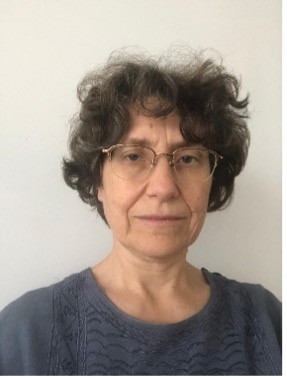
|
MSc in Agriculyural Sciences, PhD in Forage Science, is an assistant professor ad the Dept. of Veterinary Sciences of the University of Turin, Italy. Previously, she worked as a post-doc researcher and then as a research assisant at the Dept. of Agricultural Forest and Food Sciences od the same University. Her main research activities include soil organic matter turnover, manure management, nutrient losses from crop and forage syste, sustainability. She also works on the effect of agricultural practices on soil health, and in particular on soil hydrology and nutrient balance. She teaches Agronomy, Forage Science and Soil organic matter and nutrient management in agroecosystems. She authored 60 papers in the Scopus database (HI=25). |

|
PhD in Agricultural and Enviromental Engineering, He is Associate Professor at the Departement of Agricultural, Forest and Food Sciences - University of Turin. He has expertise in agricutural engineering with special regards to mineral and organic fertilizers spreaders, manure and organic waste management, nutrients and energy valorisation. He has specific competences on bio-waste treatment technologies, optimisation of biogas plants (biomass supply chain and logistic, feedstocks pre-treatments, innovative biogas plant equipment, technical solutions for treatment and efficient management of digested slurry), particulate matter, ammonia and greenhouse gas emission measurament and abatement strategies, and precision agriculture. He teaches Energy systems and renewable energy, Smart farming syste design and evaluation, and Plants for livetsock farming. He authored 50 papers in the Scopus database (HI=16). |

|
Stefania Pindozzi is an Associate Professor of Rural Building and Landscape Planning at the Department of Agricultural Sciences of the University of Naples Federico II. She holds a PhD in Science and Technologies for Environmental and Forest Management and a master’s degree in environmental Engineer with honour. She has extensive experience in research and teaching. Her main research interests include optimal manure-management strategies aimed towards a reduction in environmental impact; ammonia-emission assessment after animal-manure application to soil and inside the barn; land-use-change models; spatial multi-criteria decision analysis; ecological indicators; and energy crops' spatial allocation. She has organized special sessions and served as a guest editor for several scientific journals. Additionally, she has received research funding and led various projects/actions related to ammonia emissions reduction, water resources management, and agricultural soil remediation. She has co-authored numerous international papers and has a significant citation record in Scopus, Web of Science and Google Scholar databases. |

|
Elena Cervelli, is a researcher tenure track, (art. 24 paragraph 3-b L. 240/10) of Rural Building and Landscape Planning at the Department of Agricultural Sciences, University of Naples Federico II. She holds a PhD in Landscape Planning and Sciences and a master’s degree in Architecture with honor. She participates in interdisciplinary groups and national and international competitive calls for research funds. She has extensive experience in research and teaching. Her main research interests include the study and application of methods, models and techniques of land and landscape analysis, Geographic Information Systems - GIS, landscape metrics, land use change scenarios building, environment impacts assessment, predictive models and multi-criteria assessment - MCDA, Ecosystem Services, land marginality conditions, seismic and erosion risk analysis and management, renewable sources siting support. She is the author of essays and scientific articles on the topics developed. |
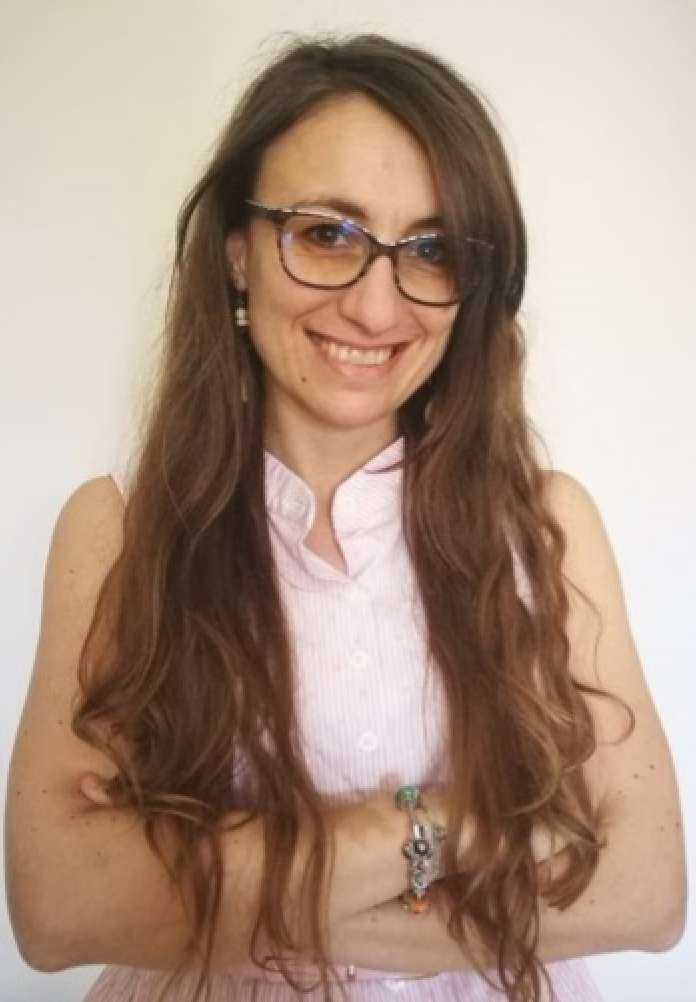
|
Ester Scotto di Perta is a researcher (art. 24 c.3-a L. 240/10) of Rural Construction and Agroforestry Territory [AGRI-04/C] at the Department of Agricultural Sciences of the University of Naples Federico II. After graduating with honours in Environmental Engineering at the University of Naples Federico II, she holds a PhD with honours in Plant and Animal Production Sciences at the University of Tuscia in Viterbo. Her research activity is carried out within the spoke 5 "Sustainable productivity and mitigation of environmental impact in animal productions" included in the "National Research Centre for Agricultural Technology - Agritech" funded by the European Union in connection with the NextGenerationUE initiative, and it focuses on the development of strategies for the optimisation of livestock manure management and its valorisation, through suitable treatments for the gaseous emissions mitigation. She is the author of 26 Scopus-indexed papers with 280 citations and an h-index of 10. |

|
PhD student at the University of Bologna, Dept. of Agricultural and Food Science and Technology. He earned his bachelor's degree in Agricultural, Forestry, and Environmental Sciences (2019) and a master's in Agricultural Sciences and Technologies (2021) from the University of Naples – Federico II. His master's thesis explored strategies for valorizing livestock manure and reducing its nitrogen content. Grieco's research aims to optimize livestock manure management to mitigate soil, air, and water pollution. He focuses on spatial analysis to assist farms and policymakers in reducing environmental impacts and identifying treatment sites and manure treatment systems for nutrient recovery, including methane production and ammonia stripping. He collaborates with local authorities and the University of Naples Federico II, contributing to scientific papers and conferences, aligning his work with the 2030 Agenda's sustainability goals. |

|
Graduated in Precision Livestock Farming in December 2023 at the Dept. of Veterinary Medicine and Animal Production of the University of Naples Federico II, she is now a research assistant at the Department of Agricultural Science of the same University.Her research career began with her experimental thesis on the use of biochar in coverage to reduce ammonia emissions from buffalo manure digestate storage, followed by a curricular internship at KU Leuven in Belgium, focused on emissions from naturally ventilated dairy barns. Her area of research concerns the management of livestock manure and their environmental impact, with particular attention to ammonia emissions, and currently collaborates on research activities on the study of gas emissions from naturally ventilated buffalo barns. |
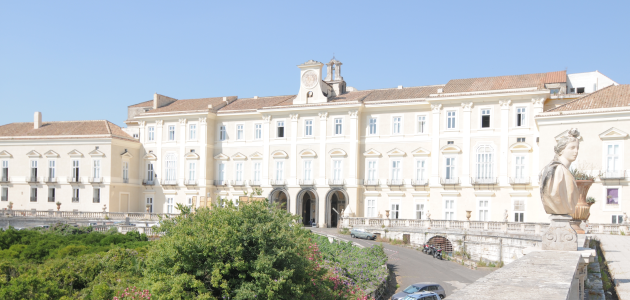
|
TBD |

|
Lucia Ottaiano is a research assistant at the Department of Agricultural Sciences of the University of Naples Federico II. After graduating with honours in Agricultural Sciences and Technologies at the University of Naples Federico II, she received his PhD in "Development and management of agro-forestry resources". His main research interests include the evaluation of greenhouse gas emissions, especially nitrous oxide, from soil compared to the type of fertilizer. She also works testing biostimulant products of plant origin on various food crops to evaluate their effects on production and quality. She authored 53 papers in the Scopus database (HI = 16). |

|
She received her bachelor's degree (2021) in Agricultural, Environmental and Forestry Sciences and your master's degree (2022) in Agricultural Sciences and Technologies from the University of Naples Federico II, Department of Agriculture. From April to October (2023) she had a research grant at the Department of Agriculture, section of Microbiology, in the following area: "Characterisation and monitoring of the process of maceration in vats of hemp fibre through the evaluation of microbiological and qualitative data" rural development programme Campania region 2014/2020. Currently, she is a PhD student in Sustainable Agricultural and Forestry Systems and Food Security and her research is based on the valorisation of waste from various agri-food chains. In particular, she studies the mineralisation of nitrogen in soil fertilised with different types of compost from different raw materials. |


The Univeristy of Naples, Federico II is the oldest public university in the world, dating back to 1224 and renowned for the very high qualification of its scientific and humanistic faculties, it is the largest research center in Southern Italy. It is divided into 3 centres, 13 faculties, 77 departments, 42 research and service centers and 2 botanical gardens. Further information is available at: www.unina.it
For research in the agri-food field in Italy the Department of Agriculture represents the point of reference. Thanks to the contribution of over 150 researchers belonging to more than 40 different disciplines, DIA research addresses the development needs of the agri-food supply chain as a whole, which can be integrated into research on the circular economy, precision agriculture, food innovation, environmental sustainability, biotechnology, bioremediation and climate change. All topics of extreme relevance and global impact, included in the operational trajectories of the 2030 Agenda for Sustainable Development, and strongly integrated into national (PNR) and European research plans (Horizon).
The Department boasts the presence of numerous researchers with a recognized international profile in their field and classified in the 2% Top Scientist Ranking of Stanford University and in the Top 1% - Highly Cited Researchers Clarivate. The latest evaluation of the quality of research assigns the DIA the national record for the area of agricultural and veterinary sciences (first out of 35 departments), assigning it the highest score among the 350 best Departments of Italian state universities admitted to compete in the selection of 180 Departments of excellence for the five-year period 2023-2027.

The University of Turin, one of the most ancient and prestigious Italian universities, hosts almost 81,000 students and over 1,600 teachers. Ranked among the top 300 universities worldwide, it has presented over 560 projects in competitions, registered 44 patents, and produced 27,400 academic publications, promoting scientific advancement and fostering dialogue between science and citizens. The university comprises 26 departments dedicated to research, teaching, and dissemination activities. Further information is available at www.en.unito.it.
Within this esteemed institution, the Department of Agricultural, Forest and Food Sciences (DISAFA) and the Department of Veterinary Sciences (DSV) collaborate closely to advance research and innovation in primary production, food processing, and veterinary sciences. DISAFA focuses on agricultural, forestry, and food systems, examining their biological, ecological, and production aspects, and addressing technological, economic-managerial, and biotechnological approaches to enhance their evolution and sustainability. DSV contributes its expertise in veterinary sciences, promoting animal, human, and environmental health through comprehensive research in clinical, livestock, and inspection disciplines. Together, these departments support interdisciplinary research and public engagement, aiming to ensure the safety and sustainability of food systems and animal products, while enhancing the overall well-being of society and the environment.
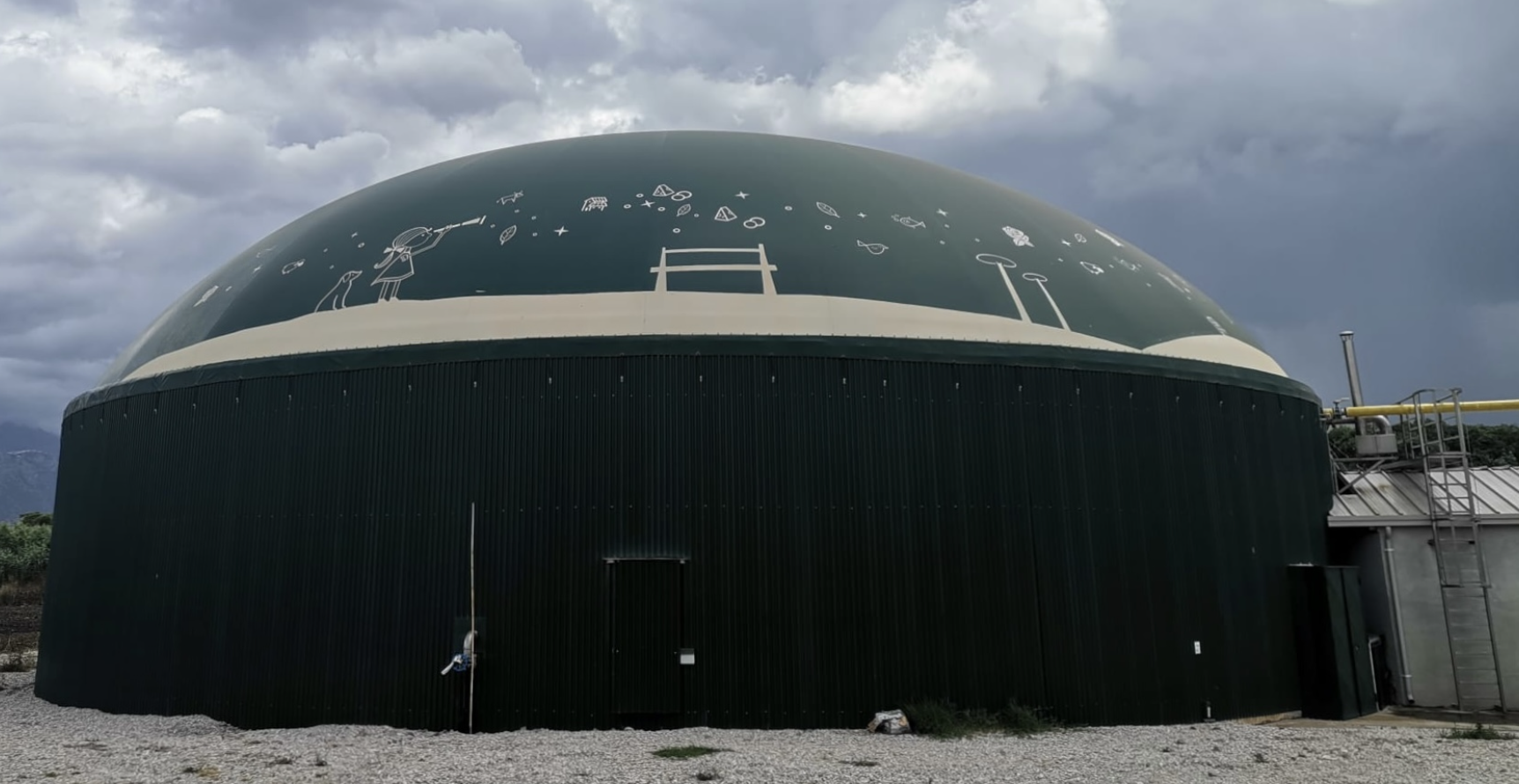
The GCS developed by the CF Energy Service S.r.l., is aiming at integrating livestock manure treatment and the production of sterilized bio-based fertilizers. The plant is located in Capaccio (SA), a small town in the Salerno Province, where are reared more than 20000 buffalo heads for milk production. The plant is fed by three surroundings buffalo farms, connected by pipelines. The total daily processing capacity is of 20500 kg/day of different agricultural organic waste, divided between buffalo manure, olive mill wastewater, dairy serum and other agricultural waste.
The delivered by-products ferment anaerobically, producing biogas and thanks to a cogenerator, 250 kW of electricity and the same amount of thermal energy are produced, entirely reused by the company itself. Furthermore, the by-products, once anaerobically digested, are extracted and separated into a solid and a liquid phase, sterilized by eliminating any toxic bacterial load, aerobically composted, deammonified, and then fed to earthworms which, proceed to a new digestion, allow to obtain very high quality organic fertilizers (lumbricompost), capable of successfully tackling the problem of greenhouse desertification.


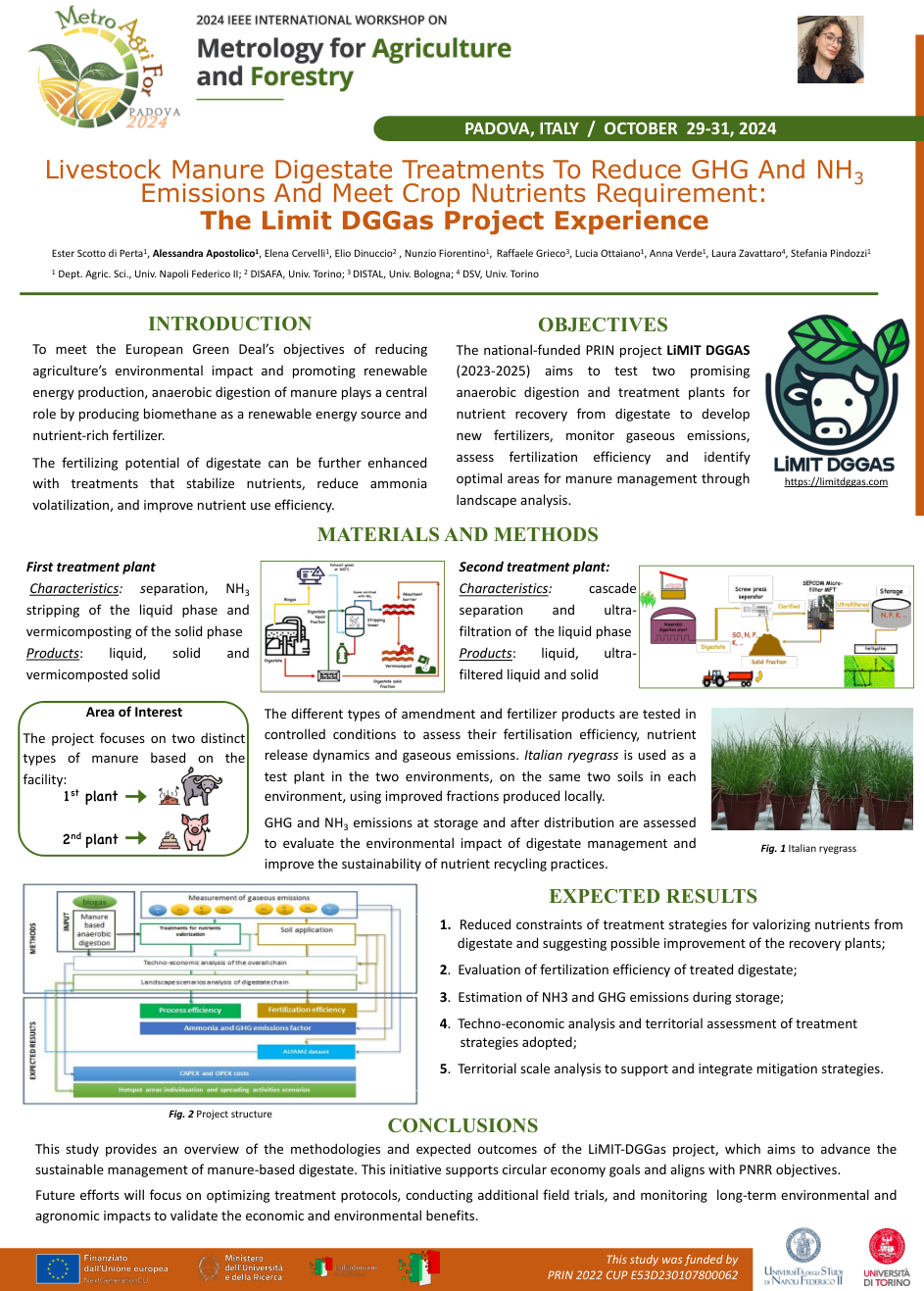
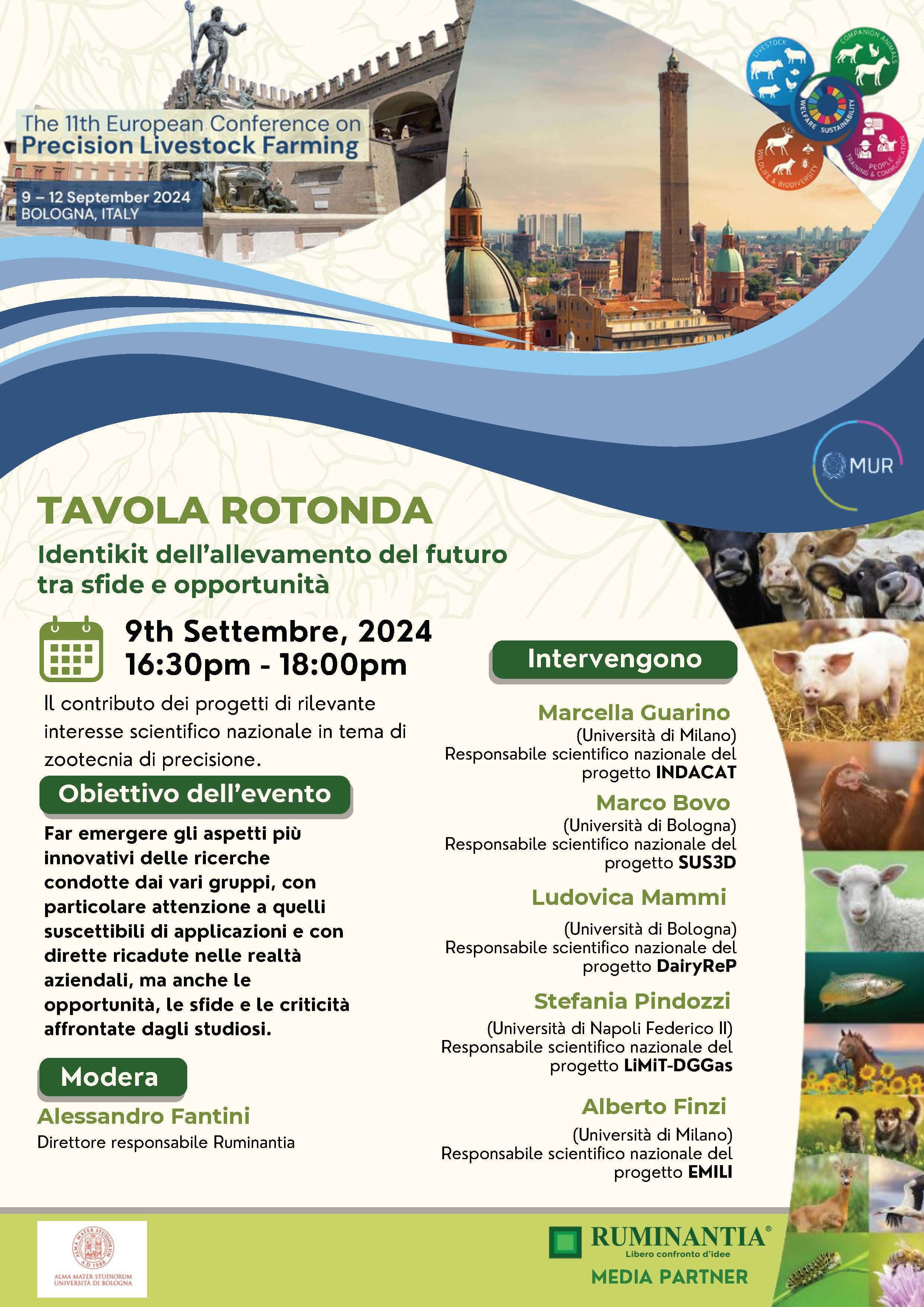

TBD